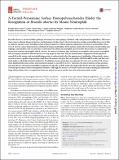| dc.contributor.author | Mora-Cartín, Ricardo | |
| dc.contributor.author | Chacón-Díaz, Carlos | |
| dc.contributor.author | Gutiérrez-Jiménez, Cristina | |
| dc.contributor.author | Gurdián-Murillo, Stephany | |
| dc.contributor.author | Lomonte, Bruno | |
| dc.contributor.author | Chaves-Olarte, Esteban | |
| dc.contributor.author | BARQUERO-CALVO, ELIAS | |
| dc.contributor.author | Moreno, Edgardo | |
| dc.date.accessioned | 2020-06-06T01:10:24Z | |
| dc.date.available | 2020-06-06T01:10:24Z | |
| dc.date.issued | 2016-06 | |
| dc.identifier.uri | http://hdl.handle.net/11056/17522 | |
| dc.description.abstract | Brucella abortus is an intracellular pathogen of monocytes, macrophages, dendritic cells, and placental trophoblasts. This bacterium causes a chronic disease in bovines and in humans. In these hosts, the bacterium also invades neutrophils; however, it fails to replicate and just resists the killing action of these leukocytes without inducing significant activation or neutrophilia. Moreover, B. abortus causes the premature cell death of human neutrophils. In the murine model, the bacterium is found within macrophages and dendritic cells at early times of infection but seldom in neutrophils. Based on this observation, we explored the interaction of mouse neutrophils with B. abortus. In contrast to human, dog, and bovine neutrophils, naive mouse neutrophils fail to recognize smooth B. abortus bacteria at early stages of infection. Murine normal serum components do not opsonize smooth Brucella strains, and neutrophil phagocytosis is achieved only after the appearance of antibodies. Alternatively, mouse normal serum is capable of opsonizing rough Brucella mutants. Despite this, neutrophils still fail to kill Brucella, and the bacterium induces cell death of murine leukocytes. In addition, mouse serum does not opsonize Yersinia enterocolitica O:9, a bacterium displaying the same surface polysaccharide antigen as smooth B. abortus. Therefore, the lack of murine serum opsonization and absence of murine neutrophil recognition are specific, and the molecules responsible for the Brucella camouflage are N-formyl-perosamine surface homopolysaccharides. Although the mouse is a valuable model for understanding the immunobiology of brucellosis, direct extrapolation from one animal system to another has to be undertaken with caution. © 2016, American Society for Microbiology. | es_ES |
| dc.description.abstract | Brucella abortus es un patógeno intracelular de monocitos, macrófagos, células dendríticas y trofoblastos placentarios. Esta bacteria causa una enfermedad crónica en bovinos y humanos. En estos huéspedes, la bacteria también invade los neutrófilos; sin embargo, no puede replicarse y simplemente se resiste a la acción asesina de estos leucocitos sin inducir una activación significativa o neutrofilia. Más allá, B. abortus causa la muerte celular prematura de neutrófilos humanos. En el modelo murino, la bacteria se encuentra dentro de los macrófagos y las células dendríticas en los primeros momentos de la infección, pero rara vez en los neutrófilos. En base a esta observación, exploramos la interacción de neutrófilos de ratón con B. aborto A diferencia de los neutrófilos humanos, de perros y bovinos, los neutrófilos de ratones ingenuos no reconocen el lisoB. abortusbacteria en las primeras etapas de la infección. Los componentes del suero normal murino no opsonizan las cepas de Brcellastra lisas, y la fagocitosis de neutrófilos se logra solo después de la aparición de anticuerpos. Alternativamente, el suero mousenormal es capaz de opsonizar rugulantes mutantes. A pesar de esto, los neutrófilos aún no pueden matar a Brucella, y el bacterium induce la muerte celular de los leucocitos murinos. Además, el suero de ratón no opsoniza a Yersinia enterocolítica O: 9, una bacteria que muestra el mismo antígeno de polisacárido de superficie que el liso B. aborto Por lo tanto, la falta de opsonización del suero murino y la ausencia de reconocimiento de neutrófilos murinos son específicos, y las moléculas responsables del camuflaje de Brucella son homopolisacáridos de superficie de N-formil-perosamina. Aunque el ratón es un modelo valioso para comprender la inmunobiología de la brucelosis, la extrapolación directa de un sistema animal a otro debe realizarse con precaución. | es_ES |
| dc.language.iso | eng | es_ES |
| dc.publisher | Universidad Nacional, Costa Rica | es_ES |
| dc.rights | Acceso abierto | es_ES |
| dc.rights.uri | http://creativecommons.org/licenses/by-nc-nd/4.0/ | |
| dc.source | Infectionand Immunity. Volume 84 Number 6. June 2016 | es_ES |
| dc.subject | BRUCELLA ABORTUS | es_ES |
| dc.subject | BRUCELOSIS | es_ES |
| dc.subject | ENFERMEDADES BACTERIANAS | es_ES |
| dc.subject | ENFERMEDADES INFECCIOSAS | es_ES |
| dc.subject | HOMOPOLYSACCHARIDES | es_ES |
| dc.title | N-formyl-perosamine surface homopolysaccharides hinder the recognition of Brucella abortus by mouse neutrophils | es_ES |
| dc.type | http://purl.org/coar/resource_type/c_6501 | es_ES |
| dc.description.procedence | Escuela de Medicina Veterinaria | es_ES |
| dc.identifier.doi | 10.1128/IAI.00137-16 | |


